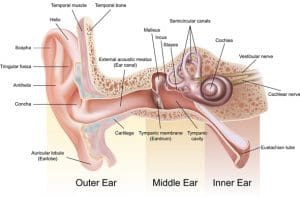Hearing Aids
Hear Better, Live BetterIs it Time for Hearing Aids?
Hearing loss is a sudden or gradual decrease in how well you can hear. It is one of the most common conditions affecting older and elderly adults. Having trouble hearing can make it hard to understand and follow a doctor’s advice, to respond to warnings, and to hear doorbells and alarms. It can also make it hard to enjoy talking with friends and family. All of this can be frustrating, embarrassing, and even dangerous.
Do others complain the TV is too loud?
Do you notice any ringing or buzzing sounds in either ear?
Do you avoid going out because you'll struggle to hear?
Do you ask others to repeat themselves?
Do you have more trouble hearing women than men?
Do you have trouble hearing in a noisy room?
Buying Hearing Aids
What You Need to Know
It is often stressful to purchase anything new, including hearing aids. When buying hearing aids, it’s important to consider a few key factors. First, consult with an audiologist to assess your specific needs. They will explain and review the features and technology available, like noise reduction and Bluetooth connectivity and assess how those features fit into your lifestyle. Comfort and fit are essential for long-term use, so make sure they feel right in your ears. Confirm that ongoing support and follow-up appointments are provided. Working with a qualified professional throughout the process is crucial to finding the most suitable hearing aids for your needs.
Brands
Find the Right Type for You
Our entire staff is assembled for one purpose: to serve our patients. Our goal is to provide you with the best possible hearing care we can, based on your individual needs.
Hearing Aid Brands We Carry






Hearing Aid FAQ
If you have a question about your hearing, you’re not alone. Current estimates place the number of hearing impaired adults in the Unites States at just over 37 million.
How does exposure to loud noise impact your hearing?
Approximately 15 percent (26 million) of Americans between the ages of 20 and 69 have high frequency hearing loss due to exposure to loud sounds or noise at work or in leisure activities.
Effects of Hearing Loss
When you have a hearing loss, the effort of listening becomes much more stressful and causes some people to experience anxiety or even high blood pressure. Often, people with hearing loss withdraw from social activities and thus, experience a loss of social connections and reduced interaction with others. Folks may become isolated or even depressed as a result. Research studies show that increased hearing loss results in reduced earning potential. A January 16, 2012, New York Times article quoting sources from Johns Hopkins University Center on Aging and Health and the National Institute on Aging reported that with every ten decibel decrease in hearing, the risk of Alzheimer’s or dementia increases by twenty percent.
“Social Connectedness” is a term to describe the social interactions and relationships people maintain. This is considered the most important factor in our overall health. When social connections and interactions decline, ALL aspects of health decline. The most important sense for maintaining social connectedness is good hearing. Helen Keller once said, “blindness separates people from things, deafness separates people from people.”
Hearing is often our most neglected sense. Perhaps that is because it is the one we can’t control or choose when to use it or because you can’t look at someone and know how well they hear. Regardless of the reason, maintaining good hearing is vital to all aspects of our being.
Even mild hearing loss has an impact on communication, occupation and recreation. Everyone should have regular hearing evaluations to document their hearing levels and thus have a baseline by which to compare future evaluations to.
There are 3 types of hearing loss:
- Sensorineural
- Conductive
- Mixed
Sensorineural hearing loss is the type people have 80% of the time. This type of hearing loss can only be helped with hearing instruments. Some aspects of sensorineural hearing loss may indicate that further medical care is warranted.
Conductive hearing loss is often medically treatable by your physician. However, your physician doesn’t know if you have a treatable hearing loss until after you have an evaluation by an Audiologist. Only an Audiologist has the expertise to evaluate properly for this type of hearing loss.
Mixed hearing loss is a combination of both types. If your hearing evaluation demonstrates this type of hearing loss, then you will most likely need to get medical treatment first (to resolve the conductive component) and then return to your audiologist for care for the sensorineural component.
The importance of having a qualified Audiologist conducting the evaluation is in identifying when a condition requiring medical follow up is present and making sure that treatment is obtained BEFORE hearing instruments are purchased.
Who is more likely to experience hearing loss, men or women?
Men are more likely to experience hearing loss than women.
Warning signals that your loved one may have hearing loss
- The TV gets louder and friends and family complain about the volume.
- They don’t hear the microwave when it beeps, or the timer on the stove.
- They don’t notice they’ve left their directional signal on because they don’t hear it.
- They don’t respond when spoken to.
- They lean in closer to people who are talking to them, often leading with one ear.
- They only seem to notice they are being spoken to if they are facing the person speaking.
- They give the wrong answers to questions.
- They frequently ask a question or introduce a topic that has just been discussed by others close by.
- They appear to have “selective hearing”.
- They smile and go along with what has been said but clearly aren’t following along.
- They stop attending social activities or events
- They have difficulty understanding young people, children, women, or others who are soft spoken.
- They are startled frequently, saying “I didn’t hear you come in”.
- They say “What?” a lot.
Anatomy of the Ear
The human ear has three sections: the Outer Ear, the Middle Ear, and the Inner Ear. These sections work together to send sound signals to the brain.
The Outer Ear consists of a large and visible flap of cartilage called the Auricle. The purpose of the Auricle is to collect sound and funnel it into the small opening at the bottom of the ear. This opening, called the Auditory Canal, directs sound down to the eardrum.
The Middle Ear begins at the eardrum. The sound hits the eardrum and causes it to vibrate. This vibration is transmitted to the bones in the Middle Ear known as the Malleus, Incus, and Stapes. The Malleus is directly attached to the eardrum on one side and to the Incus on the other. The Incus connects to the Stapes, which is responsible for sending the sound to the Inner Ear.
The Inner Ear contains “hair-like” fibers called cilia. These cilia are attached to a membrane which moves, like an ocean wave, in response to the vibration of the Stapes. As the membrane is moved, it activates the cilia for those frequencies which make up that particular sound. When the cilia are activated, an electrical signal is sent to the brain telling it which frequencies are being heard.
Exposure to loud noise will eventually cause the cilia within the Inner Ear to break off. Once broken, they cannot be repaired. When the cilia break off, the ear is no longer aware of the sounds that those cilia represent.

FOllow Up & Care
Caring for Your New Hearing Aid
Proper maintenance and care will extend the life of your hearing aid.
Make it a habit to:
Keep hearing aids away from heat and moisture.
Clean hearing aids as instructed. Earwax and ear drainage can damage a hearing aid.
Avoid using hairspray or other hair care products while wearing hearing aids.
Turn off hearing aids when they are not in use.
Replace dead batteries immediately.
Keep replacement batteries and small aids away from children and pets.
Our Offices
Austin Office
Austin, MN 55912
507-433-4144
Monday, Tuesday, Thursday:
9:00AM - 3:30PM
Owatonna Office
Owatonna, MN 55060
507-451-3879
Monday - Thursday:
8:30AM- 5:00PM
Friday: 8:30AM- 1:00PM
Waseca Office
Rochester Office
2150 2nd St SW, Suite 130
Rochester, MN 55902
507-322-4241
Monday - Thursday:
8:30AM - 5:00PM
Friday: 8:30AM- 12:00PM
Contact Us
Toll Free Phone:
1-800-804-3361
